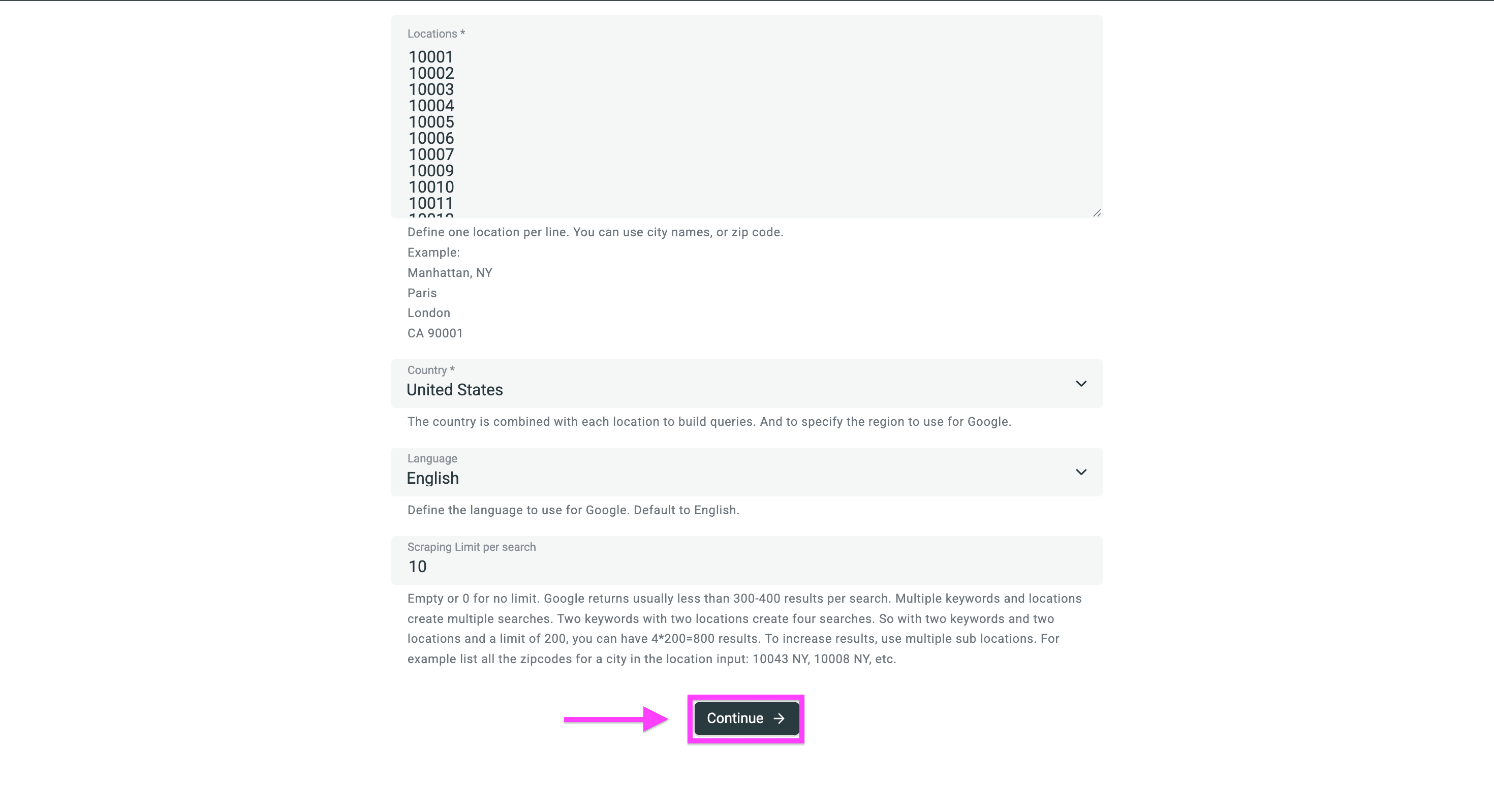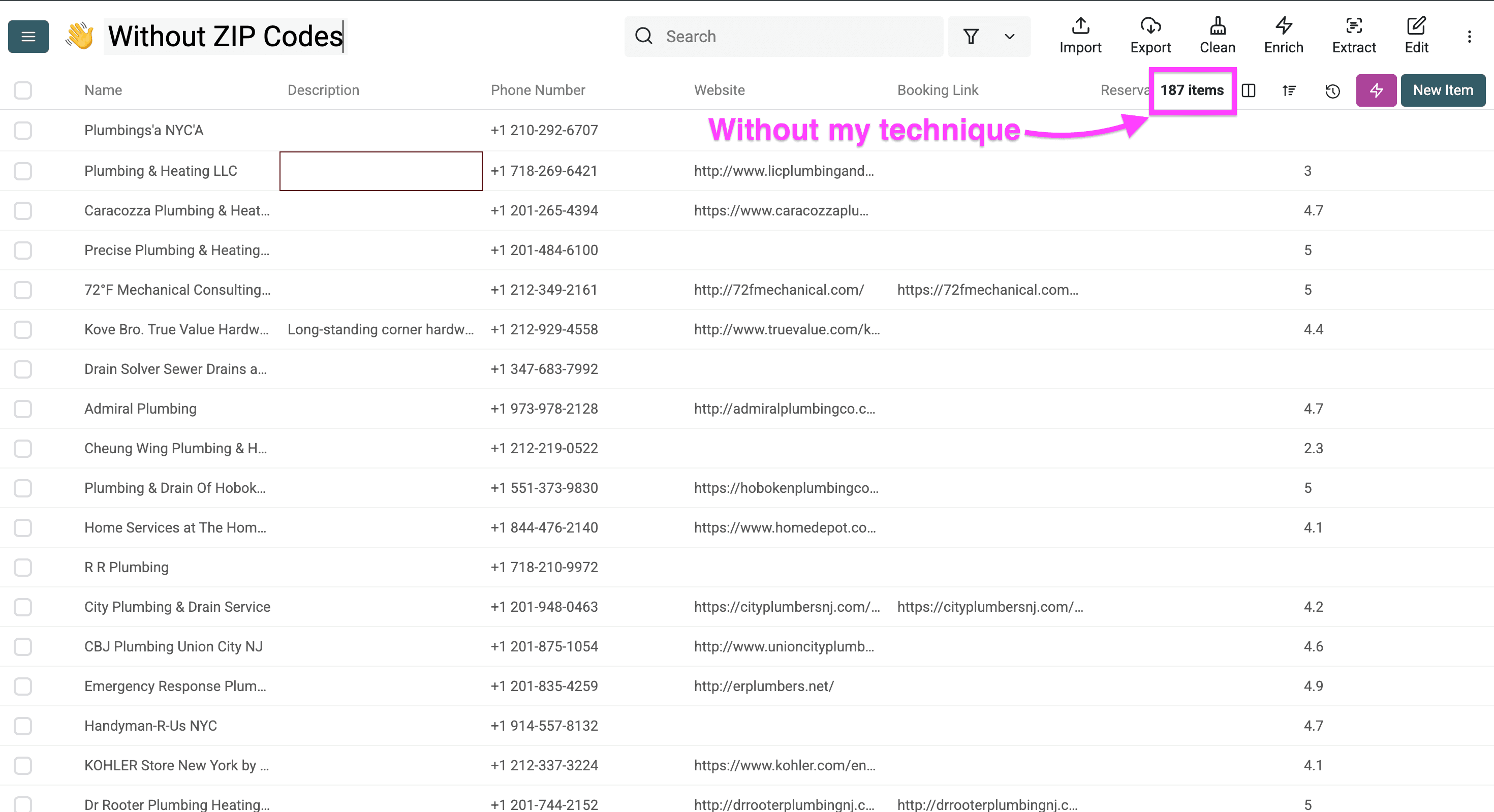Yes, scraping Google Maps is a powerful technique to target local businesses and generate leads.
Yet most people do it wrong and miss out on 60% of the leads they could get.
So if you are plan to extract data from google maps you should know about this.
What I will talk about in this guide:
- The common mistakes people makes when scraping Google Maps (1min)
- How to maximize the results when using a Google Maps data scraper (1min)
- How to use Datablist’s Google Maps scraper to get 100% coverage (2min)
The Common Mistakes People Make When Scraping Google Maps
"It's just Google Maps — what could you even do wrong, right?"
Well, not that much, but there's a small thing that costs you 60% of your scraping results if you don't know about it.
What I mean is that you don't split your search by ZIP code when scraping Google Maps — and yes, this is a huge mistake. Here's why:
If you search for plumbers in Manhattan, New York, Google Maps won't show you all plumbers but only the most relevant places in this area but if you search by ZIP code Google will show you all results for each ZIP code.
Let me prove it.
How to Maximize Your Search Results Using AI
-
Go to Claude.ai and sign up for free.
Claude sign up page -
Use this prompt template to get your ZIP codes and be specific with you command.
Claude’s interface is so nice and warm
Here’s the template: Give me all the ZIP codes for {{District, city}} in a line-by-line list with one ZIP code per line without any words in between
Here’s an example:
Give me all the ZIP codes for Manhattan, New York in a line-by-line list with one ZIP code per line without any words in between
-
Copy the ZIP codes to your clipboard.
Manhattan’s ZIP codes provided by claude
Repeat this for each location you want to scrape and break it down as precise as possible to get most extensive results.
Scraping Google Maps
To scrape Google Maps, use the Datablist Google Scraper.
Create a new collection in Datablist.
Choose the “Google Maps Scraper” as sourcing method.
Configure your search by the keywords of the businesses you want to scrape from Google Maps.
Paste all the ZIP codes you got from Claude to scrape those places and choose the country you want to scrape from
Choose then the language setting of your search.
This is crucial because: Business listings use keywords set by the owners in their local language
For example, when scraping businesses in Italy:
- Use "idraulico" instead of "plumber"
- Use "ristorante" instead of "restaurant"
This ensures you capture all relevant listings in that region.
You can also limit the number of search results per query. Here's how it works:
- Each search is a combination of:
- One keyword
- One ZIP code location
For example:
- With 100 ZIP codes and 2 keywords, you'll have 200 total searches
- If you set a limit of 10 results per search:
- Maximum results: 2,000 (200 searches × 10 results)
- Cost: 8,000 credits ($8)
Click then on “Continue” to configure your outputs.
Now you will see the option to configure your output fields.
Click on the plus to import a field. You can choose from these fields:
-
Link to place
-
Place ID
-
Name
-
Description
-
Website
-
Booking Link
-
Reservation Link
-
Rating
-
Number of reviews
-
Link to access place reviews
-
Photos count
-
Main Place photo
-
Postal address
-
coordinates
-
Timezone
-
Place type
-
Place subtype
-
working hours
-
business status
-
verification status
-
Phone number
Then click on “Run import now” to enable the Google Maps scraper.
After finishing its search Datablist’s Google Maps scraper gave me 560 plumber/plumbing companies in Manhattan.
I did the same search providing only “Manhattan, New York” as a location and received only 187 result instead of 560.
How do I scrape Google Maps to Excel?
To scrape Google Maps to Excel just use Datablist's Google Maps scraper to extract business information and export it easily. Here’s how it works:
- Create a new collection and select the Google Maps scraper
- Configure your search parameters and locations
- Choose your desired output fields (business names, addresses, phone numbers, etc.)
- Run the scraper and get your results in a clean spreadsheet format
- Export the Google Maps data as Excel (.xlsx) or CSV
The tool handles the technical complexities of scraping while delivering accurate, structured data ready for business use.
Frequently Asked Questions (FAQ)
Is Google Maps scraping legal?
Google Maps scraping is legal when done responsibly. While using automated tools to collect publicly available business data is permitted, it's essential to respect scraping best practices. Always use the gathered information appropriately for legitimate business purposes.
What information can you extract from Google Maps scraping?
Google Maps scraping can extract valuable business information including:
- Business names and addresses
- Phone numbers and websites
- Operating hours
- Customer ratings and reviews
- Business categories
- Photos and descriptions This data can be used for market research, lead generation, and competitive analysis.
What are the best tools for scraping Google Maps?
Several reliable tools exist for Google Maps scraping:
- Datablist (covered in this guide) - offers comprehensive features and an affordable pricing and it works for non-technical people too
- Google Maps API - official but has usage limits and high costs
- Custom Python scripts - requires technical knowledge Choose based on your needs, technical expertise, and scale of data collection.
How can I use Google Maps scraping data for my business?
Google Maps scraping data can be utilized in multiple ways:
- Generate leads for sales and marketing
- Conduct market research and analysis
- Build business directories
- Identify potential business partnerships
- Track competitor locations and activities
- Create targeted marketing campaigns Remember to clean and verify the data before using it in your business operations.















